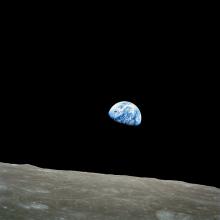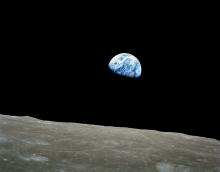Listen to today's episode of StarDate on the web the same day it airs in high-quality streaming audio without any extra ads or announcements. Choose a $8 one-month pass, or listen every day for a year for just $30.
You are here
Moon and Planets
The Moon probably owes its existence to a “big whack” — a collision between the young Earth and another planet about the size of Mars. The impact blasted a ring of debris into orbit around Earth. This material then coalesced to form the Moon.
A recent study says that the impact initially produced a system that hardly resembles the current Earth-Moon configuration.
Researchers created computer models of the collision that took into account the current configuration. Their simulations showed that Earth was knocked almost over on its side, and spun on its axis once every couple of hours. And the Moon orbited in the plane of Earth’s equator.
Over time, a complex interplay of the gravity of Earth, Moon, and Sun caused some changes. The Moon moved away from Earth a bit, the tilt of its orbit changed, and Earth spun slower on its axis. Once the Moon reached a certain distance, its gravity pulled Earth into a more upright position. And tides in the Moon\'s crust, which are like ocean tides on Earth, changed the angle of the Moon’s orbit.
The result of all of this is a system were Earth is tilted at about 23 degrees, and the Moon’s orbit is slightly askew relative to Earth’s orbit around the Sun — the result of a big whack and a lot of maneuvering.
Look for the Moon in the southwest as night falls this evening. The orange planet Mars stands close to its lower right, with Venus, the brilliant “evening star,” farther along the same line.
Script by Damond Benningfield






